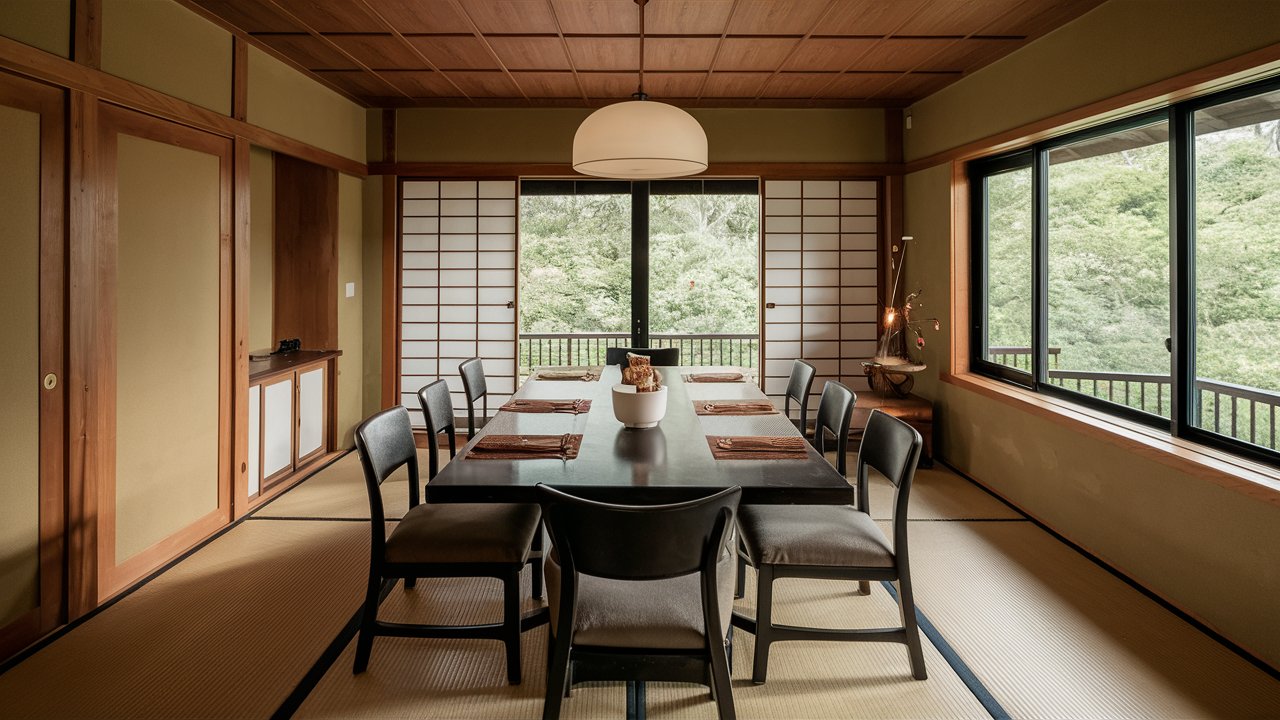Disclosure: Some links on this site are affiliate links. As Amazon Associates, we earn from qualifying purchases (at no cost to you).
Looking to transform your dining room into a serene and stylish haven? Japandi decor, a harmonious blend of Japanese minimalism and Scandinavian simplicity, is taking the interior design world by storm.
If you’re ready to embrace this trend, here are 25 Japandi dining room decor ideas that will inspire you to create the perfect blend of elegance and comfort.
25 Japandi Dining Room Decor Ideas
1. Neutral Color Palette
Start with a neutral color palette featuring shades of white, beige, and light gray. These colors form the foundation of Japandi decor, creating a serene and harmonious environment.

This palette allows natural light to flow through the room, enhancing the calming effect. By keeping the colors muted, you can ensure that the space remains uncluttered and soothing, making it easier to relax and enjoy your meals.
2. Natural Materials
Incorporate natural materials like wood, bamboo, and rattan into your dining room. These elements add warmth and texture, reflecting the Japandi emphasis on nature. Wooden dining tables, bamboo chairs, and rattan light fixtures can bring a sense of organic beauty to the space.

Using these materials not only connects your decor to the natural world but also adds a tactile quality that enhances the overall dining experience.
3. Minimalist Furniture
Choose minimalist furniture with clean lines and simple shapes. Avoid overly ornate designs and opt for pieces that are both functional and beautiful.

A streamlined dining table paired with sleek chairs embodies the Japandi aesthetic, creating a clutter-free and visually appealing dining area. This approach ensures that every piece of furniture serves a purpose without overwhelming the space.
4. Low-Profile Seating
Incorporate low-profile seating like benches and floor cushions, which are inspired by traditional Japanese dining setups.

This style promotes a sense of intimacy and connection during meals. Low-profile seating also helps to maintain an open and airy feel in the dining room, preventing it from feeling cramped or crowded.
5. Organic Textures
Introduce organic textures through textiles and decor. Linen tablecloths, woven placemats, and cotton napkins add a tactile dimension to your dining room.

These materials are not only pleasing to the touch but also contribute to the natural, grounded feel that is central to Japandi design. They provide a subtle contrast to the smooth surfaces of your furniture and enhance the overall sensory experience.
6. Muted Accent Colors
While the primary palette is neutral, muted accent colors like soft greens, blues, and earthy tones can add depth and interest.

These accents should be subtle and blend seamlessly with the overall color scheme. Using muted colors prevents any single element from dominating the space, maintaining the tranquil atmosphere that Japandi decor aims to achieve.
7. Functional Decor
Opt for functional decor that serves a purpose beyond aesthetics. Items like elegant teapots, handcrafted bowls, and beautiful but practical storage solutions embody the Japandi principle of beauty in utility.

This approach ensures that every item in your dining room is both useful and visually pleasing, reducing clutter and enhancing the room’s functionality.
8. Simple Table Settings
Keep table settings simple and elegant. Choose minimalist dinnerware, flatware, and glassware that complement the clean lines of your furniture.

Avoid overly decorative pieces and opt for designs that are understated yet refined. This simplicity allows the focus to remain on the food and the company, rather than on elaborate table settings.
9. Greenery and Plants
Add a touch of nature with greenery and plants. Choose low-maintenance indoor plants that thrive in your home’s lighting conditions.

Bonsai trees, potted bamboo, and succulents can add a fresh and natural element to your dining room. Greenery not only enhances the aesthetic but also contributes to a healthier indoor environment.
10. Natural Light
Maximize natural light to create a bright and welcoming dining space. Use sheer curtains or blinds that can be adjusted to control the amount of sunlight entering the room.

Natural light enhances the neutral color palette and makes the space feel more open and airy. It also helps to highlight the natural materials and textures used in the decor.
11. Handcrafted Items
Incorporate handcrafted items such as pottery, ceramics, and woven baskets. These items add a unique and personal touch to your dining room.

Handcrafted pieces often have a story behind them, bringing character and a sense of history to your space. They also emphasize the value of craftsmanship and the beauty of imperfection, which are key elements of Japandi design.
12. Open Shelving
Use open shelving to display beautiful and functional items. This can include dinnerware, glassware, and decorative pieces.

Open shelves create an airy feel and make it easy to access the items you use frequently. They also provide an opportunity to showcase your style and personality through carefully curated displays.
13. Scandinavian-Inspired Lighting
Incorporate Scandinavian-inspired lighting fixtures such as pendant lights and floor lamps with clean lines and natural materials.

These lights provide ample illumination while adding to the overall aesthetic. Lighting is crucial in setting the mood and enhancing the functionality of your dining room, making it a key element of Japandi decor.
14. Tatami Mats
Consider using tatami mats as flooring or as a decorative element in your dining room. Tatami mats add a traditional Japanese touch and create a warm, inviting atmosphere.

They are made from natural materials like straw and rush grass, which complement the Japandi emphasis on nature and simplicity.
15. Sliding Doors
Incorporate sliding doors or screens to separate spaces within your dining area. Sliding doors save space and add a touch of traditional Japanese architecture to your home.

They can be used to create a sense of privacy or to divide the dining room from other areas while maintaining an open feel.
16. Wall Art
Choose minimalist wall art that complements the Japandi aesthetic. Simple, abstract pieces or nature-inspired prints can add visual interest without overwhelming the space.

The key is to select artwork that enhances the tranquility and simplicity of the room.
17. Mix of Cultures
Blend Japanese and Scandinavian design elements seamlessly. For example, pair a Japanese-style low dining table with Scandinavian chairs for a unique and balanced look.

This fusion of styles creates a harmonious and eclectic space that reflects the best of both worlds.
18. Clutter-Free Space
Maintain a clutter-free space by incorporating smart storage solutions. Built-in cabinets, under-seat storage, and minimalist sideboards help keep your dining room organized and free from unnecessary items.

A clutter-free environment enhances the sense of calm and order that is central to Japandi design.
19. Textural Contrast
Create textural contrast by combining different materials such as wood, stone, and fabric. This adds depth and interest to your dining room while maintaining a cohesive look.

For example, pair a wooden dining table with stoneware dishes and linen napkins for a rich, layered effect.
20. Simplicity in Patterns
Use simple patterns sparingly to add subtle visual interest. Geometric designs, stripes, and understated florals can complement the overall aesthetic without overpowering the space.

Patterns should be used in moderation and in harmony with the neutral color palette.
21. Eco-Friendly Elements
Incorporate eco-friendly elements such as sustainably sourced wood, recycled materials, and energy-efficient lighting.

This not only aligns with the Japandi emphasis on nature and simplicity but also promotes a more sustainable lifestyle.
22. Soft Textiles
Add soft textiles like cushions, throws, and rugs to create a cozy and inviting atmosphere. Choose natural fibers like wool, cotton, and linen for a touch of warmth and comfort.

These textiles add a layer of softness to the minimalist decor, making the dining room feel more welcoming.
23. Candlelight Ambiance
Enhance the dining experience with candlelight. Use simple, elegant candle holders and unscented candles to create a warm, inviting ambiance.

Candlelight adds a touch of romance and tranquility to your dining room, perfect for intimate dinners and gatherings.
24. Japanese Tableware
Use Japanese tableware such as ceramic plates, bowls, and chopsticks to add an authentic touch to your dining room.

These items not only enhance the dining experience but also contribute to the overall aesthetic. Opt for simple, elegant designs that reflect the Japandi emphasis on beauty in simplicity.
25. Personal Touches
Finally, add personal touches that reflect your style and personality. This could include family heirlooms, travel souvenirs, or handmade items.

Personal touches make the space uniquely yours and add a layer of depth and meaning to the decor.
FAQ
Q: What is Japandi decor? A: Japandi decor is a fusion of Japanese minimalism and Scandinavian simplicity. It combines the best of both styles to create a serene, functional, and aesthetically pleasing environment.
Q: How do I start incorporating Japandi decor into my dining room? A: Begin with a neutral color palette, incorporate natural materials, and choose minimalist furniture. Focus on simplicity, functionality, and a connection to nature.
Q: What are some key elements of Japandi design? A: Key elements include neutral colors, natural materials, minimalist furniture, functional decor, and a clutter-free environment. Combining Japanese and Scandinavian design principles is central to this style.
Q: Can I mix other styles with Japandi decor? A: While Japandi decor is a blend of Japanese and Scandinavian styles, you can incorporate elements from other design styles as long as they complement the overall aesthetic and maintain the principles of simplicity and functionality.
Q: How can I make my dining room feel cozy with Japandi decor? A: Add soft textiles like cushions, throws, and rugs, use warm lighting such as candles or soft lamps, and incorporate natural materials to create a warm and inviting atmosphere.
Final Thoughts
Japandi decor offers a unique and beautiful way to design your dining room, blending the simplicity and elegance of Japanese and Scandinavian styles. By incorporating these 25 ideas, you can create a space that is not only functional but also serene and aesthetically pleasing.
Whether you’re hosting a dinner party or enjoying a quiet meal, your Japandi dining room will provide a tranquil and stylish backdrop for all your dining experiences. Happy decorating!











